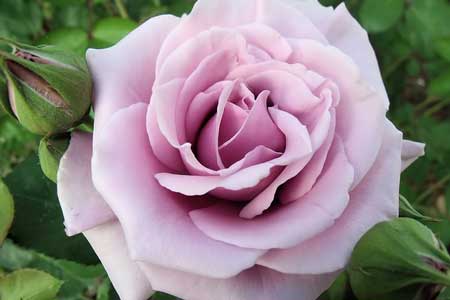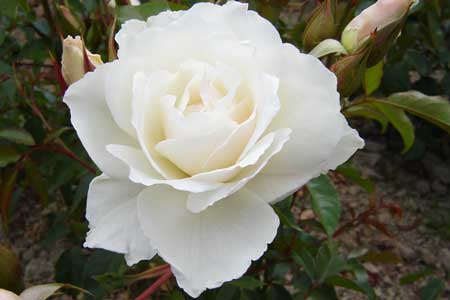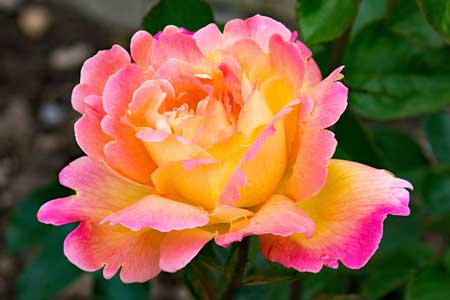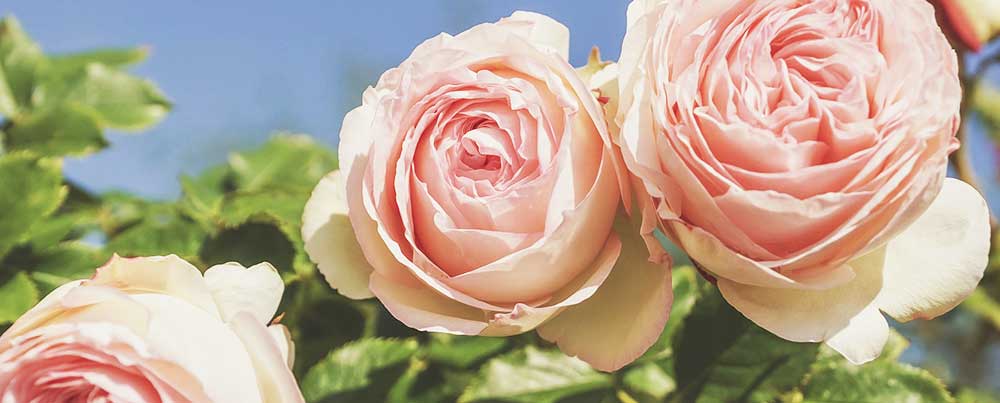Roses
How to grow
Originating from China, the earliest modern rose was the tea rose but, now, roses are found in almost every garden and deservedly have the title ‘Queen of the Flowers’. With centuries of breeding, modern roses today flower continuously from spring to autumn. There are single, semi-double and double flowered forms in every colour imaginable, often with an intoxicating fragrance.
At a Glance:
- Plant in full sun for best results
- Thrive in a rich, well-drained soil
- Flower from Spring thru to Autumn
Selection
Roses are deciduous shrubs—i.e. they lose their leaves in Winter.

Hybrid Tea roses grow from 1 to 2 metres in height with large double flowers on single stems. Some are fragrant.
Floribunda roses grow 1 to 1.5 metres in height with many clusters of flowers on one stem.
Climbers or pillar roses grow 2 metres plus in height. Some have hybrid tea type flowers, others have floribunda clusters.
Old Fashioned roses are often called species roses. Some grow to 4 metres in height, some are fragrant and have colourful hips in winter.
English roses (modern shrub) are bred to retain the best old fashioned rose traits of fragrance and flower form, but benefit from modern breeding being disease resistant and continuous flowering. They grow to a height of 1 to 2 metres.
David Austin roses are popular English roses.
Miniature roses grow from a height of 15 to 50cm, are compact bushes, require very little pruning and are great in patio pots and tubs.
Where to Plant
- Plant in a sunny, open position.
- Roses like a rich well drained soil. Prepare the soil before planting by digging in plenty of compost, and a dressing of Tui Rose food.
- Raise beds in clay soil to improve drainage, and add Gypsum to help break down the clay.
When to Plant
The best time to plant is in winter. If planting in spring or summer, keep well watered.

How to Plant
Before planting cut away any damaged branches. Aim for 3 to 4 main leaders - use sharp secateurs. Cut the main leaders to within 4 to 5 buds from the base of the plant.
Plant the rose to a depth level with the bud union just above the soil.
Refer to our handy helper "How to Plant Trees, Shrubs and Roses" more information
After Care...
Feeding
Roses require regular feeding. Use a balanced fertiliser such as Tui Rose fertiliser. Feed roses in early spring when new growth appears and again in mid summer. Water the fertiliser in well.
Watering
Roses require regular watering throughout summer. Deep watering is more effective than light sprinklings. Avoid wetting the foliage as this encourages the spread of fungus diseases.
Mulching
Mulch roses in early spring and again in mid summer with a compost or mulch. This keeps the roots cool and moist.

- Prune roses when they are dormant in winter.
- Remove weak or diseased growth to encourage new growth in spring.
- Always use sharp secateurs.
- Make the pruning cut 5mm above a bud on a 45 degree angle slanting backwards.
- Remove spent flower heads in summer for continuous flowering.
Refer to our handy helper "How to Prune Roses" more information
Pests and Diseases
For all of their beauty, roses do require regular spraying and maintenance to keep them pest and disease free. For best results spray Nichol's Combat for Roses when Roses are in leaf, otherwise you can use some of the following methods!
Aphids are small sucking insects that appear on new growth. Hose off, squash with fingers or spray with Nichol's Combat for Roses.
Rose Scale are sucking insects that look like fine white flakes stuck to the stem. Control with Conqueror Oil mixed with an insecticide. It is best to control this in winter rather than when the rose is in leaf, in order to prevent leaf burn.
Mites are minute sucking insects found on the under-side of leaves causing distortion, speckling and silvering of leaves. Spray with Mavrik
Black spot appears as dark brown/black spots in yellow rings on the leaf, usually in summer. Avoid wetting the foliage when watering. Copper Fungicide can be sprayed as a protectant.
Powdery Mildew appears as a white floury powder on the leaf surface. Improve air circulation around the plant. Spray with Yates Fungus Fighter or Nichol's Combat for Roses
Rust appears as orange spots on the underside of the leaf and turns black. Spray with Nichol's Combat for Roses.
Downy Mildew is a disease sometimes confused with Black Spot as it appears the same. Downy Mildew tends to attack Roses in early spring while Black Spot attacks in late spring and summer. Spray with Nichol's Combat for Roses, Yates Liquid Copper or Grosafe Free Flo Copper
Good watering, feeding, pruning and air circulation will help keep your roses healthy and disease free.
Other Uses
Roses are wonderful cut flowers.
There is a range of patio roses available suitable for pots. If growing roses in containers they need to be regularly watered and fed. Use a slow release fertiliser. We recommend Tui Novatech, or Burnets Gold Rose Food.

9971